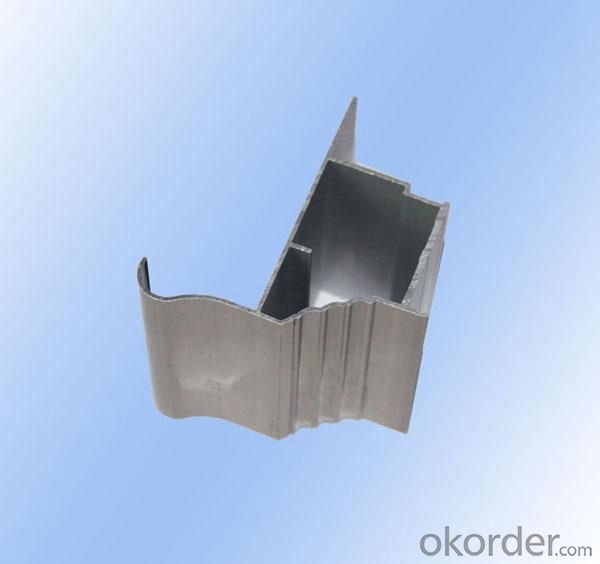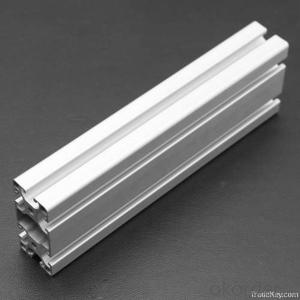Aluminum Alloy Profiles for Kitchen Cabinet Frame Door Frames
- Loading Port:
- Shanghai
- Payment Terms:
- TT OR LC
- Min Order Qty:
- 5 m.t.
- Supply Capability:
- 10000 m.t./month
OKorder Service Pledge
OKorder Financial Service
You Might Also Like
Item specifice
1. Specification of Aluminum Alloy Profiles for Kitchen Cabinet Frame Door Frames
Alloy | AA1050,AA1060, AA1070, AA1100 |
Temper: | H12, H14, H16, H18, H22, H24, H26, H32,HO, F |
Thickness: | 0.10-500mm |
Width: | 10mm- 2200mm |
Standard: | GB/T3880-2006, ASTM, ISO, EU standard |
Special Specification is available on customer’s requirement | |
2. Application of Aluminum Alloy Profiles for Kitchen Cabinet Frame Door Frames
wall cladding, ceilings, bathrooms, kitchens and balconies, shutters, doors,windows…
3. Feature of Aluminum Alloy Profiles for Kitchen Cabinet Frame Door Frames
Surface Quality :
Be free from Oil Stain, Dent, Inclusion, Scratches, Stain, Oxide Decoration, Breaks, Corrosion, Roll Marks, Dirt Streaks and other defect which will interfere with use,
Mochenical Property:
Chemical Composite and Mechanical Property
4. Certificate:
SGS and ROHS(if client request, paid by client), MTC(plant provided), Certificate of Origin(FORM A, FORM E, CO), Bureau Veritas and SGS (if client request, paid by client), CIQS certificate
5. Image of Aluminum Alloy Profiles for Kitchen Cabinet Frame Door Frames



6. Package and shipping of Aluminum Alloy Profiles for Kitchen Cabinet Frame Door Frames
First, plastic cloth with drying agent inside; Second, Pearl Wool; Third, wooden cases with dry agent, fumigation wooden pallets, aluminum surface could cover blue PVC film
7. FAQ
Question 1: What is your MOQ?
We accept one ton per type for an order. But the detail we could negotiate.
Question 2: What is your normal terms of payment?
We always trade with you by T/T. But we also accept the L/C as you require.
Question 3: How many kinds of the surface treatment we can choose?
You could choose different color of powder coated. Anodized of black. matte silver, nature, champagne, bronze color. Mill finished. Wooden finished and printed.etc.
Question 4: Can you supply OEM services?
We offer OEM services for 17 years.
Question 5: How many days for opening the mould?
Normally about 10 days.According to the difficulty of your drawing.
Question 6: Can i choose the package what i want?
Yes, of course. We offer various kinds of package.e.g.PE foam. Shrink film. Wrapping paper.
But we would give you professional suggestion of package.
- Q:The latest list of aluminum China
- Lear aluminum is also good Oh, A Well-Known Trademark in China, China energy-saving innovation enterprise ten, Hebei enterprises in Handan
- Q:What are the different grades of aluminum used in profiles?
- There are several different grades of aluminum that are commonly used in profiles. The specific grade chosen depends on the desired characteristics and intended application of the profile. Some of the most common grades include: 1. 6061-T6: This grade is one of the most versatile and widely used aluminum alloys. It offers excellent strength, corrosion resistance, and machinability, making it suitable for a wide range of applications such as structural components, frames, and automotive parts. 2. 6063-T5: This grade is known for its excellent extrudability, making it a popular choice for profiles used in architectural applications, such as window frames or door frames. It offers good corrosion resistance and can be easily surface-treated or anodized. 3. 6082-T6: This grade is similar to 6061-T6 in terms of strength and corrosion resistance, but it is often preferred for applications that require higher weldability. It is commonly used in the transportation industry, such as in the manufacturing of truck and trailer components. 4. 7075-T6: This grade is known for its exceptional strength and high stress resistance. It is commonly used in aerospace applications, such as aircraft structures and missile components, where strength and lightweight properties are critical. 5. 3003-H14: This grade is primarily used for its excellent formability and corrosion resistance. It is often chosen for profiles used in decorative applications, such as trim or architectural accents. These are just a few examples of the different grades of aluminum used in profiles. Each grade offers unique properties and advantages, allowing for a wide range of applications across various industries. It is important to select the appropriate grade based on the specific requirements and performance expectations of the profile being manufactured.
- Q:Aluminum profile connecting piece
- Very little to buy this alone, and only with industrial aluminum suppliers. - selling on Taobao is also a way if the price is appropriate.
- Q:What are the safety features of aluminum profiles in construction?
- Aluminum profiles are a popular choice for construction due to their range of safety features. They are both lightweight and durable, making them easy to handle and install while still providing structural integrity. This reduces the risk of accidents or injuries during the construction process. Furthermore, aluminum profiles are non-combustible, meaning they do not contribute to the spread of fire. This is crucial for ensuring the safety of occupants and minimizing fire-related hazards. In addition, aluminum profiles have excellent corrosion resistance properties. They are naturally resistant to rust and decay, allowing them to withstand harsh environmental conditions and maintain their structural integrity over time. This is particularly important in coastal or humid areas where corrosion risk is high. Moreover, aluminum profiles can be designed to incorporate safety features such as non-slip surfaces or grooves for enhanced grip and stability. This is especially beneficial in applications where slip and fall accidents may occur, such as staircases or walkways. Additionally, aluminum profiles offer excellent electrical conductivity, making them advantageous for electrical installations. Their high thermal conductivity helps dissipate heat efficiently, reducing the risk of overheating or electrical malfunctions. Lastly, aluminum profiles are recyclable, aligning with sustainable construction practices and contributing to waste reduction and environmental impact. In conclusion, the safety features of aluminum profiles in construction, including their lightweight yet durable nature, non-combustibility, corrosion resistance, ability to incorporate non-slip surfaces, excellent electrical conductivity, and recyclability, make them a safe and sustainable choice for construction projects.
- Q:Can you quote me one according to the current market situation?
- Aluminum: aluminum ingot + processing fee + Spray + heat insulationAluminum plate: square meter, unit price (depending on thickness) + spraying, etc.You cannot quote without specific parameters
- Q:Can aluminum profiles be used in the production of electronics?
- Yes, aluminum profiles can be used in the production of electronics. Aluminum is a lightweight, corrosion-resistant metal with excellent thermal conductivity, making it suitable for various electronic applications. It is commonly used in the construction of electronic enclosures and heat sinks. Aluminum profiles can be easily formed into different shapes and sizes, allowing for customization and flexibility in designing electronic components. Additionally, aluminum profiles are often used for electromagnetic shielding purposes due to their electrical conductivity. Overall, the use of aluminum profiles in electronics manufacturing offers numerous advantages such as durability, thermal management, and design versatility.
- Q:What are the advantages and disadvantages of the use of magnesium profiles compared with aluminum profiles?
- 5 specific gravity density: under the same volume conditions, magnesium alloy is lighter than aluminum alloy, which is the advantage of magnesium alloy.6 modulus of elasticity: the frame made of magnesium alloy is more rigid than aluminum alloy frame, and the frame made of the same thickness and caliber can absorb more trampling force when riding, which will influence riding efficiency.
- Q:What are the fire-resistant properties of aluminum profiles?
- Aluminum profiles offer a range of fire-resistant qualities that render them suitable for a variety of uses. Firstly, aluminum boasts a remarkably high melting point of around 660 degrees Celsius (1220 degrees Fahrenheit), enabling it to endure extreme temperatures without succumbing to melting or compromising its structural integrity. Furthermore, aluminum possesses a low ignition point, necessitating a higher temperature than other metals to ignite. This attribute reduces the likelihood of aluminum catching fire when exposed to heat or flames. In the event of a fire, aluminum profiles generate a protective layer of aluminum oxide on their surface owing to their innate oxide layer. This layer acts as a barrier, impeding the propagation of flames and hindering the combustion process. Moreover, the aluminum oxide layer exhibits exceptional heat resistance, thereby providing supplementary defense against elevated temperatures. Additionally, aluminum profiles are non-combustible, meaning they do not contribute to the expansion of a fire. This characteristic assumes critical importance in ensuring fire safety by containing the fire within a specific zone and averting rapid spreading. Taken together, the fire-resistant attributes of aluminum profiles, encompassing their high melting point, low ignition point, the formation of a protective oxide layer, and non-combustibility, establish them as a dependable choice for a wide range of applications where fire safety is a paramount concern.
- Q:Are aluminum profiles suitable for exhibition kiosks?
- Yes, aluminum profiles are suitable for exhibition kiosks. Aluminum is lightweight, durable, and easy to work with, making it an ideal material for constructing kiosks. Additionally, aluminum profiles can be customized and offer a sleek and modern appearance, enhancing the overall aesthetics of the exhibition kiosk.
- Q:What's the difference between aluminum oxide and electrophoresis?
- Oxidation is the production of hydrogen through sulfuric acid and water to crystallize the surface of the substrate. The oxidation is followed by electrophoresis! After acid treatment, is 60 to 75 degrees hot soup Xipai acid is in the electrophoretic anode electrophoresis paint electrophoresis and long service life! Generally 25 years or so! Oxidation work for 9 years, I hope to help you, please adopt, thank you
1. Manufacturer Overview |
|
|---|---|
| Location | |
| Year Established | |
| Annual Output Value | |
| Main Markets | |
| Company Certifications | |
2. Manufacturer Certificates |
|
|---|---|
| a) Certification Name | |
| Range | |
| Reference | |
| Validity Period | |
3. Manufacturer Capability |
|
|---|---|
| a)Trade Capacity | |
| Nearest Port | |
| Export Percentage | |
| No.of Employees in Trade Department | |
| Language Spoken: | |
| b)Factory Information | |
| Factory Size: | |
| No. of Production Lines | |
| Contract Manufacturing | |
| Product Price Range | |
Send your message to us
Aluminum Alloy Profiles for Kitchen Cabinet Frame Door Frames
- Loading Port:
- Shanghai
- Payment Terms:
- TT OR LC
- Min Order Qty:
- 5 m.t.
- Supply Capability:
- 10000 m.t./month
OKorder Service Pledge
OKorder Financial Service
Similar products
New products
Hot products
Related keywords






























